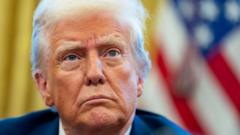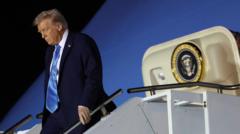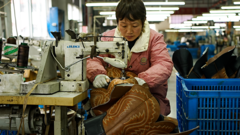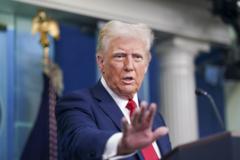In Haiphong, Vietnam, the industrial landscape has dramatically changed, reflecting the region's response to tariffs on China. Local residents witness firsthand the transformation from rural life to booming trade, but the future remains uncertain with potential shifts in U.S. politics.
Northern Vietnam's Transformation: The Impact of Trump's Tariffs

Northern Vietnam's Transformation: The Impact of Trump's Tariffs
The tariffs imposed by the Trump administration have sparked an unexpected industrial boom in Northern Vietnam, particularly in Haiphong, as global markets seek alternatives to China.
In recent years, Northern Vietnam, and Haiphong in particular, has experienced rapid economic growth driven largely by the global search for alternatives to Chinese manufacturing, a trend that gained traction during former President Donald J. Trump's tenure. In the midst of this industrial upheaval, residents celebrate the influx of new opportunities, jobs, and the air of prosperity that has enveloped their communities.
Haiphong, a port city that once struggled with economic stagnation, has become a hub for manufacturing with factories sprouting like mushrooms in a once-quiet landscape. Pham Van Thinh, a 73-year-old retired police chief and local resident, observes this transformation from his patio, describing the nearby LG electronics factory as a beacon of hope. “It makes me happy,” he reflects, noting how the youth in his community are finding better prospects.
Just six years ago, the region was characterized by rice fields and limited economic prospects. However, after Trump implemented tariffs on Chinese goods, Vietnam effectively positioned itself as a viable alternative destination for foreign investment. The effects were immediate: industrial parks filled with both Vietnamese and Chinese enterprises looking to expand operations and mitigate the impact of the tariffs.
As a result, what were once rural hamlets have rapidly evolved into bustling towns, with some growing overnight to accommodate the influx of workers. Trade deficits have shifted as Vietnam has emerged as one of the countries with the largest purchase volumes from the U.S, now recording significant trade imbalances with China.
Despite this growth, uncertainty looms regarding the direction of U.S. policy and how a potential second Trump term could affect these dynamics. As the world watches, Northern Vietnam's future hangs in the balance, caught between the euphoria of newfound prosperity and the unpredictable tides of international trade relations.
Haiphong, a port city that once struggled with economic stagnation, has become a hub for manufacturing with factories sprouting like mushrooms in a once-quiet landscape. Pham Van Thinh, a 73-year-old retired police chief and local resident, observes this transformation from his patio, describing the nearby LG electronics factory as a beacon of hope. “It makes me happy,” he reflects, noting how the youth in his community are finding better prospects.
Just six years ago, the region was characterized by rice fields and limited economic prospects. However, after Trump implemented tariffs on Chinese goods, Vietnam effectively positioned itself as a viable alternative destination for foreign investment. The effects were immediate: industrial parks filled with both Vietnamese and Chinese enterprises looking to expand operations and mitigate the impact of the tariffs.
As a result, what were once rural hamlets have rapidly evolved into bustling towns, with some growing overnight to accommodate the influx of workers. Trade deficits have shifted as Vietnam has emerged as one of the countries with the largest purchase volumes from the U.S, now recording significant trade imbalances with China.
Despite this growth, uncertainty looms regarding the direction of U.S. policy and how a potential second Trump term could affect these dynamics. As the world watches, Northern Vietnam's future hangs in the balance, caught between the euphoria of newfound prosperity and the unpredictable tides of international trade relations.






















